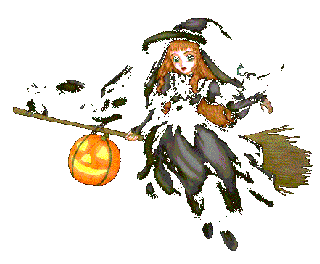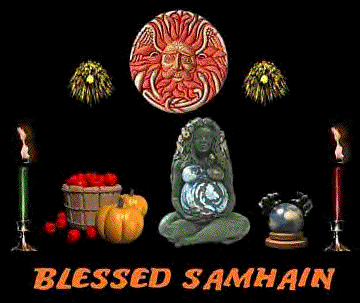Behold The Mystery | home
Samhain

SAMHAIN is the 1st day of winter in the old Celtic year, marking the
end of one season and decline of daylight. It is the beginning of the year in many Wiccan/Witchcraft Traditions, as well as the festival for the dead.
Samhain was originally a Druidic festival celebrated on the eve of November. As part of the celebration a bonfire was lit and torches carried the fire back to the family hearths.
In ancient times bonfires were also set to encourage the sun
to return as the days continued to grow shorter and colder with winter nearing.
|
Samhain is considered a time where the veil between this world and the Otherworld (sidh) was very thin, when the spirits of the dead moved freely between the worlds. Since thedoorway was opened at this time of year, it was commonly believed that fairies and other creatures of folklore wandered amoung the living as well.
Therefore offerings were left to appease them so they would not harm the living.
|
Following the rise of Christianity, this festival period came to be called Hallowmas, or All Hallow's Eve, from which our word Halloween comes from. In the 10th century Christian monks observed this Pagan celebration and the problem it's popularity presented to the conversion efforts of the Church. They decided to cook up large batches of fava soup and offer them up for the souls of the dead on the street corners of the towns. Hungry peasants took great delight in the large cauldrons of fava bean soup over which the monks presided. The Church allowed the practices of this season to continue
because of the conversion opportunities available to the monks who fed the poor. It wasn't until the 15th century that the Church officially called the day of celebration AS Christian, calling it "Ognissanti" or All Soul's Say.
The offering of beans to the dead, such as the fava bean soup custom, dates back to archaic Roman religion when black beans were thrown over the shoulder to ward off troubled souls. The spirits of the dead were belived to gather up the beans as offerings and departs in peace.
|
Samhain / Halloween
One of the 4 major Sabbats, Samhain, our time of endings and our time
of beginnings. Samhain is the Witches' New Year. It is said to be the
time when the veil between the worlds is very thin, when souls are
leaving this physical plane and souls are coming back
(reincarnating). Samhain is when darkness increases. The Goddess
reigns as the Crone and the God, Dark Lord, passes into the
underworld to become the seed of his own rebirth. Divination is
heightened on this night.
Samhain is also known as Halloween, All Hollows Eve, Day of the Dead,
All Saint's Eve, Celtic Winter, Feast of Spirits, Celtic New Year,
and Samhuinn and is celebrated on October 31st.
Symbols used to represent Samhain are: jack-o'-lantern, balefire,
besom, masks, cauldron, Waning Moon.
Foods in tune with Samhain are: apples, pumpkin pie, beets, turnips,
hazelnuts, corn, gingerbread, pomegrantates, cider, herbal teas, pork
dishes.
|
The plants & herbs associated with Samhain are: mugwort, allspice,
sage, gourds, catnip, apple trees.
For Samhain incense and oil you can use any of the following scents,
either blended together or alone: frankincense, basil, yarrow, lilac,
ylang-ylang, clove, camphor.
Colors associated with Samhain are: black, orange, red, brown, golden
yellow.
Stones associated with Samhain are: obsidian, onyx, carnelian
Animals and mythical beasts associated with Samhain are: bats, cats,
dogs, Phooka, goblins, Medusa,
Appropriate Samhain Goddesses are all Crone Goddesses, Underworld
Goddesses. Some Samhain Goddesses are: Hecate (Greek), Carlin
(Scottish), Edda (Norse), Pamona (Roman), Crobh Dearg (Irish), Lilith
(Hebrew), Psyche (Greek), the Morrigu/Morrigan (Celtic).
Appropriate Samhain Gods are all Death Gods, Aged Gods, Underworld
Gods. Some Samhain Gods are: Arawn (Welsh), Dis (Roman),
Kronos/Cronus (Greco-Phoenician), Xocatl (Aztec), Woden (Teutonic),
Pluto (Greco-Roman), Hades (Greek), Nefertum (Egyptian).
Altar decorations can consist of: small jack-'o-laterns, foods from
the harvest, photographs of your loved ones who have departed this
world, statue or figurine of the Goddess in her Crone aspect.
Traditional activities during Samhain consist of: divination, past-
life recall, spirit contact, drying of winter herbs.
Taboos on Samhain are: travel after dark, eating grapes or berries
Spellwork can be for: protection, neutralizing harm.
|

